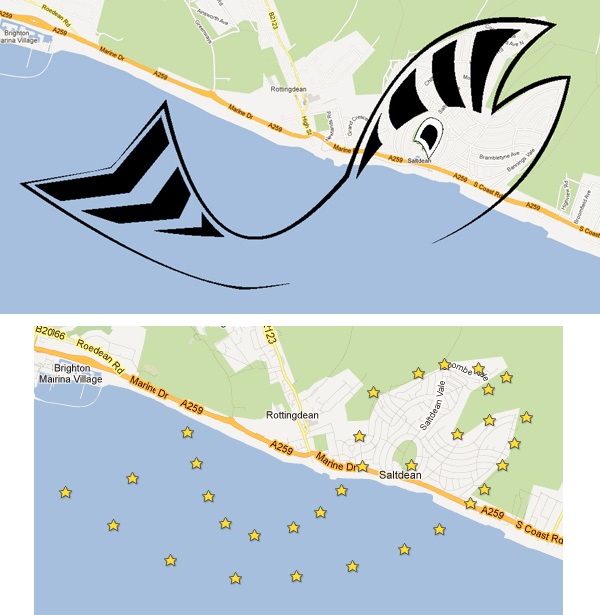Is it just me, or does the urban area of Saltdean look like the head of a big fish leaping out of the sea... OK... just me then. In order to cement this image in everyone else’s mind, I have devised a series of puzzle caches to outline the rest of this fictional fish and called it, “Big Fish”. The Art work is by my son, thanks Ev.

This series links up to the Saltdean Border caches to draw the whole big fish on the Geocache map, so they are numbered as a single sequence. These are all puzzle caches based on HIDATO puzzles. HIDATO means “Find the path” and solving them all will reveal a path which you can follow to collect all the caches. I have started with nice easy puzzles at #16 working up through moderate ones to wickedly hard by #32. Even if you have never done a HIDATO before, you can learn by starting at the easy ones and working your way up from there.
If you collect them in numerical order you will do a walk from Rottingdean, through Ovingdean to Roedean and back to Rottingdean again.
HIDATO Puzzle No16

Cache location = N 50 48.ABB, W 000 0B.CDB
Personally I found that the red letters needed for mapping the solution to the co-ords got in the way when I was solving the puzzles. I have therefore provided a version of the puzzle image minus those letters on the cache page gallery

Notes about solving a HIDATO
These extra notes are on this page only. To solve a HIDATO you must fill in the missing numbers making a path of consecutive numbers, 1-2-3-4-5-6-7- etc. Each consecutive number must be one square from the last, vertically, horizontally or diagonally. In each puzzle the first and last numbers are circled. You are finding a path from the first to last number. You don't have to solve it in order. In fact, it is essential to do the easiest bits first and leave the tricky bits until last.
To get the cache co-ords you must first solve the puzzle. Then examine the numbers you have placed in the squares that have red letters in them. The red letters are not part of the HIDATO. They are just to give you the co-ords. The red letters represent digits in the co-ordinates of the cache, the asterixes represents digits you don’t need for the co-ordinates. (i.e. if you decide the number that goes in a square labelled *D is 13 then the value of D is 3, or if the number that goes in a square labelled E* is 21 then the value of E is 2. If a square contains a single letter with no asterix, then you know it is a low number between 1 and 9.
Worked Example
In order to demonstrate how a solution looks and give out a few solving tips, here is a worked example of a 6x6 puzzle. Personally I don't think Hidato are as difficult as most Sudoku, and definitely not as hard as Kakuro or Hanjie. A 9x9 Hidato takes me about 5 - 7 minutes to solve, but I've been doing them a while. Here is an example 6x6 Hidato to go through step by step.

I find it helpful to draw the path as a line, shown in blue. First do the bits you are given for free.

Start with the easiest bits first. You never do a Hidato from the start to the finish, you do the easiest sections where the gaps between given numbers are the shortest first. The section where we have the most numbers is the teens. Look at the 19. 18 must be placed next to 19, i.e. in B6 or D6. It can’t go in D6, because then it won’t link to 16. So put 18 in B6. Now we know 20 must go in D6. Now the only place for no 21 is E6. Next, because 18 has taken B6, that means 15 must go in C4 to link 14 to 16.

Corners can give away moves in HIDATO. Although 17 could go in A5 or A6, if it goes in A5 there is no way to put a number in A6, so 17 goes in A6. Same goes for 23. It could go in F4, F5 or F6, but if it goes in F4 or F5 then we will be stuck with a blank in F6, so 23 goes in F6. Now 24 and 25 must go in F5 and F4 respectively. Also because we put 15 in C4, 35 must go in D4.

Now we have placed 35 in D4 we need to link 32 to 35 in two jumps. 34 could go in C3 or E3, but if it went in C3 there is nowhere to put 33. Therefore 34 must go in E3, and then we see that 33 must go in E2. Now look at square A5. We have filled in B5, A6 and B6 with numbers that do not link to square A5. Therefore we know that A5 must link to the only two remaining squares around it, A4 and B4. The only way to do this is to put 12 in A5, and 11 in A4.

Now we have placed 34 and 35, there is now only one path from 25 to 31. We can write in 26 to 30

Now we just need to make the last link from 2 to 8. There is now only one way to do this, as shown.

And the path is complete! Sometimes I just draw the line while I solve the puzzle. There's no real need to actually write the numbers in, until you need to get the cache co-ords that is.
Happy path finding